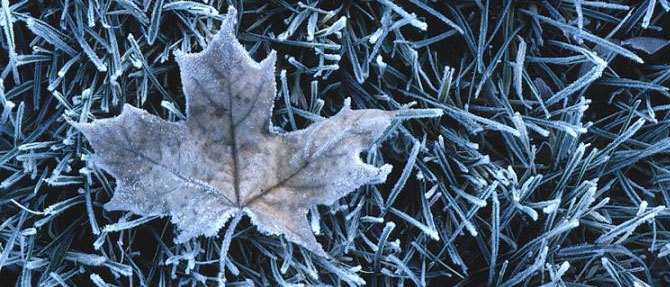Frost occurs on clear, still nights. As the air temperature approaches freezing, the surface temperature of plants can dip below freezing, causing ice crystals to form in the same manner that dew forms on warmer nights. Because temperatures vary just a few feet above the ground, frost can form when your thermometer reads above freezing. Freezing temperatures may or may not be accompanied by frost.
For all but the most tender plants, it doesn’t matter whether the conditions produce a frost or a freeze. What’s important is how cold it got and for how long. There are multiple methods that you can apply to help your plants survive the cold and minimise the risk of frost damage:
Covering Plants
The most popular way to guard against frost is with the use of some type of covering. Almost anything will work, but old blankets, sheets, and even burlap sacks are best. When covering plants, drape them loosely and secure with stakes, rocks, or bricks. The lighter covers can simply be placed directly over the plants, but heavier covers may require some type of support, such as wire, to prevent the plants from becoming crushed under the weight. Covering tender garden plants in the evening will help retain heat and protect them from freezing. However, it is important that the covers be removed once the sun comes out the following morning; otherwise, the plants may fall victim to suffocation.
Watering Plants
Another way to protect plants is by watering them a day or two before the frost is expected. Wet soil will hold more heat than soil that is dry. However, do not saturate the plants while the temperatures are extremely low, as this will result in frost heave* and ultimately injure the plants. Light watering in the evening hours, before temperatures drop, will help raise humidity levels and reduce frost damage.
* Frost heave is an upwards swelling of soil during freezing conditions caused by an increasing presence of ice as it grows towards the surface, upwards from the depth in the soil where freezing temperatures have penetrated into the soil.
Mulching Plants
Some people prefer to mulch their garden plants. This is fine for some; however, not all tender plants will tolerate heavy mulching; therefore, these may require covering instead. Popular mulching materials that can be used include straw, pine needles, bark, and loosely piled leaves. Mulch helps to lock in moisture and during cold weather, holds in heat. When using mulch, try to keep the depth at about two to three inches.
Cold Frames for Plants
Some tender plants actually require over-wintering in a cold frame or indoors. Cold frames can be purchased or built easily at home. Wood, cinder blocks, or bricks can be used for the sides and old storm windows can be implemented as the top. For those needing a quick, temporary frame, simply incorporate the use of baled hay or straw. Stack these around your tender plants and apply an old window to the top.
Raised Beds for Plants
Designing a garden with raised beds will also help guard plants against frost during cold temperatures. Cold air tends to collect in sunken areas rather than higher mounds. Raised beds also make covering of plants easier.
As well as protecting your existing plants, if you live in an area that suffers from regular frosts, you may also want to consider growing plants that can handle the colder temperatures. Here are some of our recommendations:
Edibles
- Broccoli
- Kale
- Brussels Sprouts
- Cabbage
- Spinach
- Turnip
Vegetable growing tip: In general, brassica crops are tolerant to frost. This includes broccoli and cabbage as well as cauliflower and radishes. Lettuce is another vegetable that performs best in cool weather.
Whichever type of vegetables you choose to plant, be sure to look at the directions on the seed packet or plant tag. These directions will guide you so the particular variety you have chosen will do its best.
Just because you have a vegetable that is considered frost tolerant doesn’t mean all varieties of that vegetable can withstand the same temperatures. It is important to note planting times and days to maturity in relation to your frost dates.
Herbs
- Thyme
- Oregano
- Sage
- Marjoram
- Rosemary
- Mint
- Parsley
Flowers
- Heuchera
- Pansy
- Lily of the Valley
- Snap Dragon
- Winter Daphne
- Dianthus
- Calendula
- Violet
- Poppy
- Hosta






